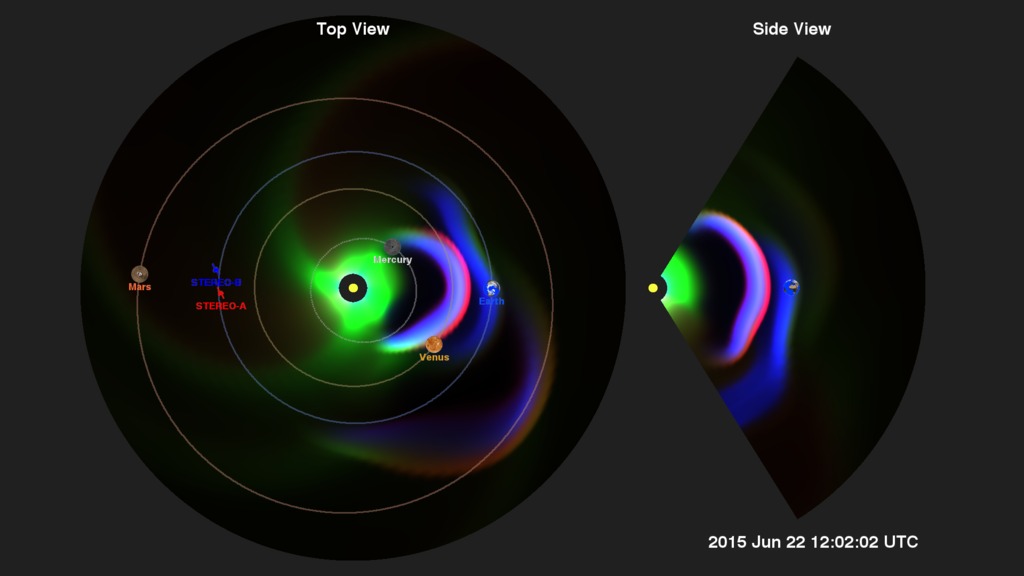Space Weather Imagery of June 22 - 23, 2015 Events
The sun emitted a CME and mid-level solar flare, peaking at 2:23 p.m. EDT, on June 22, 2015. Again on June 25, 2015, a mid-level solar flare peaked at 4:16 a.m. EDT.
NASA’s Solar Dynamics Observatory, which watches the sun constantly, captured an image of the event. Solar flares are powerful bursts of radiation. Harmful radiation from a flare cannot pass through Earth's atmosphere to physically affect humans on the ground, however -- when intense enough -- they can disturb the atmosphere in the layer where GPS and communications signals travel.
To see how this event may affect Earth, please visit NOAA's Space Weather Prediction Center at http://spaceweather.gov, the U.S. government's official source for space weather forecasts, alerts, watches and warnings.
This first flare is classified as an M6.6 flare and the second was M7.9. M-class flares are a tenth the size of the most intense flares, the X-class flares. The number provides more information about its strength. An M2 is twice as intense as an M1, an M3 is three times as intense, etc.

SDO blended image in 131 and 171 angstroms of an M7.9 flare on June 25, 2015. Credit: NASA/SDO

SDO blended image in 131 and 171 angstroms of an M6.6 solar flare on June 22, 2015. Credit: NASA/SDO

SDO image in 131 angstroms of an M6.6 solar flare on June 22, 2015. Credit: NASA/SDO

SDO image in 171 angstroms of an M6.6 solar flare on June 22, 2015. Credit: NASA/SDO
Video of SOHO C3 showing CMEs on June 18 - 23, 2015. Credit: NASA/SOHO
Video of SOHO C3 showing CMEs on June 18 - 23, 2015. Credit: NASA/SOHO

View of a CME on June 20, 2015 from the Solar and Heliospheric Observatory, or SOHO. Earth-directed CMEs like this one are often called halo CMEs, because the material shooting off from the sun looks like a ring around the disk of the sun. This halo can be seen more clearly in the right-hand image called a difference image, which is created by subtracting two consecutive frames to see how the image has changed. Credit: NASA/SOHO

View of the June 20, 2015 CME from the Solar and Heliospheric Observatory, or SOHO. Earth-directed CMEs like this one are often called halo CMEs, because the material shooting off from the sun looks like a ring around the disk of the sun. This halo can be seen more clearly in the right-hand image called a difference image, which is created by subtracting two consecutive frames to see how the image has changed. Credit: NASA/SOHO

View of the June 22, 2015 CME from the Solar and Heliospheric Observatory, or SOHO. Earth-directed CMEs like this one, which started at 2:36 pm EDT on June 22, are often called halo CMEs, because the material shooting off from the sun looks like a ring around the disk of the sun. This halo can be seen more clearly in the right-hand image called a difference image, which is created by subtracting two consecutive frames to see how the image has changed. Credit: NASA/SOHO
For More Information
See NASA.gov
Credits
Please give credit for this item to:
NASA's Goddard Space Flight Center
-
Producers
- Genna Duberstein (USRA)
- Scott Wiessinger (USRA)
-
Scientist
- C. Alex Young (NASA/GSFC)
-
Science writing fellow
- Sarah Frazier (ADNET Systems, Inc.)
Release date
This page was originally published on Tuesday, June 23, 2015.
This page was last updated on Wednesday, May 3, 2023 at 1:49 PM EDT.
